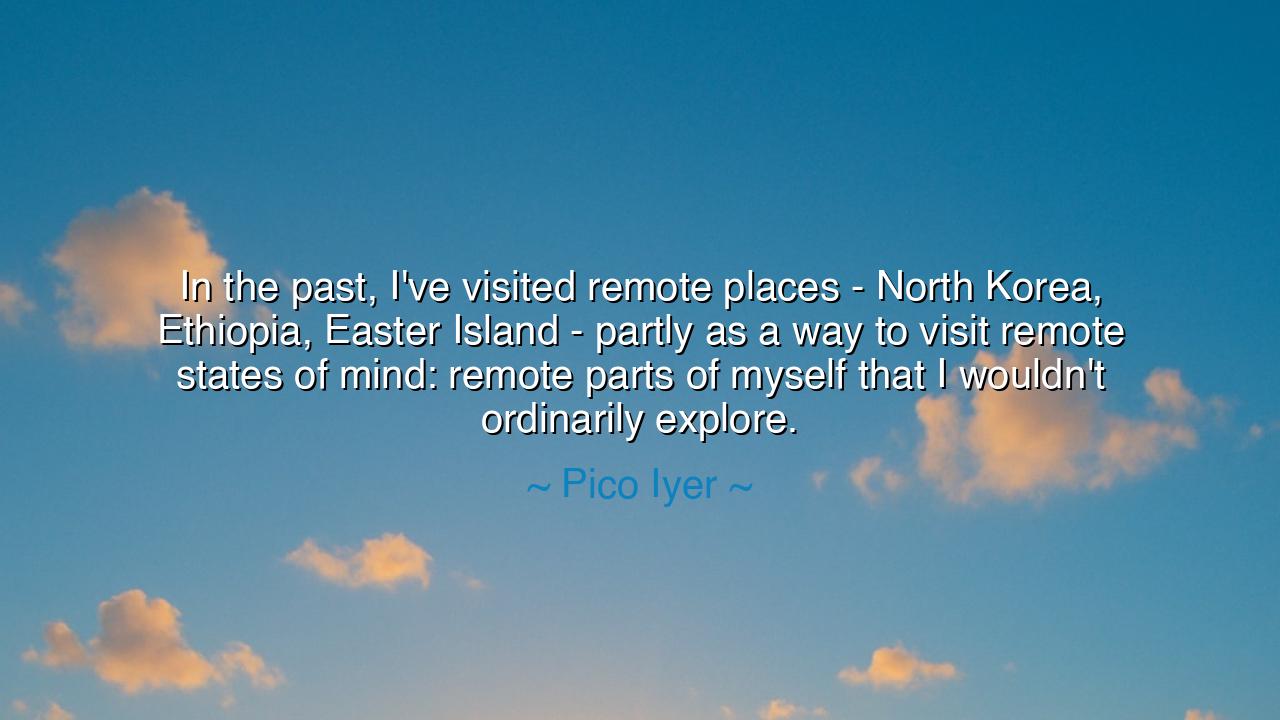
In the past, I've visited remote places - North Korea, Ethiopia
In the past, I've visited remote places - North Korea, Ethiopia, Easter Island - partly as a way to visit remote states of mind: remote parts of myself that I wouldn't ordinarily explore.






In the luminous words of Pico Iyer, we are invited to gaze into a truth that lies at the heart of every journey — that travel is not merely a movement through space, but a voyage through the inner landscape of the soul. “In the past, I've visited remote places — North Korea, Ethiopia, Easter Island — partly as a way to visit remote states of mind: remote parts of myself that I wouldn't ordinarily explore.” With these words, Iyer reveals that exploration is not just an act of curiosity about the world, but an act of revelation of the self. The deserts, ruins, and islands we traverse are mirrors reflecting our hidden emotions, forgotten dreams, and untested beliefs. The outward path leads inward, and the further we travel into the unknown, the deeper we descend into the heart’s own wilderness.
To understand the origin of this thought, one must know the traveler who spoke it. Pico Iyer, born to Indian parents, raised in England and educated in America, has spent his life moving between cultures — neither belonging fully to one, nor severed from any. His writing, filled with luminous introspection, bridges the worlds of East and West, silence and noise, belonging and solitude. In visiting the world’s most remote places, he sought not adventure for its own sake, but insight — to test the boundaries of what it means to be human, to strip away comfort and discover the edges of identity. In such solitude, the noise of the world fades, and the voice of the soul grows clearer.
This vision of travel as an inward pilgrimage is as old as humanity itself. The ancients called it the journey of transformation. The prophet retreats into the desert, the monk into the mountain, the hero into exile — not to escape the world, but to find himself anew. When Moses wandered the wilderness, he found not only a new land but a new law; when Buddha sat beneath the Bodhi tree, he discovered that the greatest pilgrimage is one that circles back to the heart. Iyer’s journeys to North Korea or Easter Island echo this sacred pattern: the more barren the landscape, the richer the revelation. For in the silence of such places, we meet the parts of ourselves that ordinary life keeps hidden beneath the noise of routine.
Consider the story of Antoine de Saint-Exupéry, the aviator-writer who crashed in the Sahara Desert and nearly died of thirst. In that vast emptiness, he experienced not only the frailty of the body but the immortality of the spirit. He later wrote The Little Prince, a tale not of deserts and stars alone, but of rediscovered innocence — the childlike wisdom buried within every adult. His physical isolation became a mirror of inner discovery, just as Iyer’s remote travels became a map of his inner terrain. Both men understood that the farther one travels from the familiar, the closer one comes to the essence of being.
Iyer’s “remote states of mind” are those we seldom allow ourselves to enter: solitude, uncertainty, vulnerability, awe. In modern life, where noise and speed are worshipped as virtues, such inner places are neglected, even feared. Yet, it is in these states that wisdom ripens. To stand on Easter Island, among the silent faces of stone, is to feel the smallness of one’s own time. To walk through the quiet streets of Pyongyang is to confront the fragility of freedom. To wander through Ethiopia’s highlands is to taste endurance and faith. Each journey, though outwardly different, leads toward the same horizon: the rediscovery of self through encounter with the strange.
The meaning of this quote, then, is not confined to travel alone. It speaks to the deeper rhythm of all human growth: we must sometimes step into the unfamiliar, the uncomfortable, the distant, in order to awaken what lies dormant within us. The remote places of the earth are metaphors for the unexplored corners of the soul — our fears, our doubts, our longings for beauty and meaning. Just as explorers once set sail beyond the edge of known maps, so too must each person journey beyond the borders of comfort to encounter their own inner wilderness. Without such journeys, the spirit stagnates; with them, it expands and transforms.
The lesson Iyer offers is both tender and timeless: seek not only to see new lands, but to see with new eyes. Whether your journey is across oceans or across a single day, let it awaken parts of yourself that sleep. Dare to go where your thoughts seldom dwell — into silence, solitude, and reflection. Sit with your discomfort, walk into your uncertainty, and listen to what they have to teach. For the true traveler, as the ancients knew, does not conquer the world; he discovers himself within it.
So let us remember this wisdom: to visit the world is to visit the soul. Go forth not only to collect sights and stories, but to uncover the hidden continents of the heart. When you stand before the vastness of the earth — the icy winds of the Arctic, the silence of a temple, or the shadowed face of your own fear — know that you are standing before your own reflection. And when you return, you will not be the same. For the one who dares to explore both the outer and inner wilderness finds what all sages seek — the union of the world without and the world within, and the peace that is born when the traveler finally meets himself.






AAdministratorAdministrator
Welcome, honored guests. Please leave a comment, we will respond soon